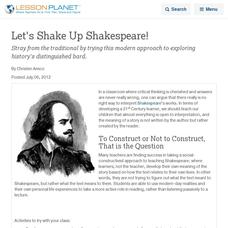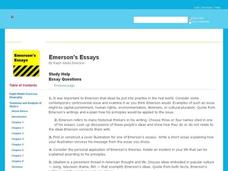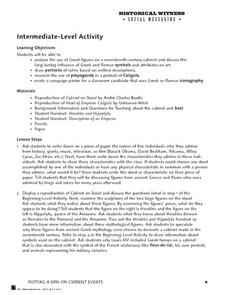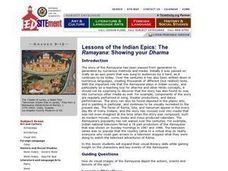Curated OER
Let's Shake Up Shakespeare!
Stray from the traditional by trying this modern approach to exploring history's distinguished bard.
Macmillan Education
A Class or Company Newsletter: A Collaborative Writing Lesson
A class newsletter? The possible extensions for this activity are endless. After examining examples of news print-outs from hotels or workplaces, class members develop their own articles and produce a newsletter. A great way to keep...
Curated OER
History of Miss America
Students make a time-lines of of decades using images from Miss America. In this history lesson, students looks at the country's beauty pageant and how it changes the lives of women in America. Students debate issues such as size...
Curated OER
Images, Empathy, and the Humanitarian Impulse
High schoolers study humanitarian intervention and its role in society. For this politics lesson students view a video on Darfur and discuss what they learned.
Curated OER
Health Education: Advertising
Fourth graders become conscientious consumers. In this personal health lesson plan, 4th graders analyze techniques used in advertising health-related products and services.
Curated OER
Emerson's Essays - Essay Questions
In this literature worksheet, students respond to 12 short answer and essay questions about Emerson's Essays. Students may also link to an online interactive quiz on the novel at the bottom of the page.
Curated OER
Picture Perfect Pyramid
Young scholars investigate the concept of the food pyramid. The lesson includes background information for the teacher to lecture students about the food pyramid. They construct a model of the pyramid using cereal boxes. The projects...
Curated OER
Baked Polymer Clay 3D People Portraits
Learners discuss methods of building forms with clay (ball and variations, snake, flat sheets). They draw a stick figure of what their sculpture may look like, including correct figure proportion.
Curated OER
Greek and Roman Symbolism
Students explore Greek and Roman symbolism in art. In this visual art lesson, students draw portraits of ancient leaders based on the written descriptions they read about them. Students also design campaign posters using Greek or Roman...
Curated OER
Arti-Factual Evidence
Practice responding to controversial information with the New York Times lesson provided here. Middle schoolers watch a video interview with the director of The Lost Tomb of Jesus. After reading a companion article, they identify the...
Creative Educator
Fantastic Fractions
Groups of learners create an animation illustrating fractions using common objects. They choose everyday objects that they can divide into fractions. They take pictures of the objects dividing into fractions and create an animation with...
Curated OER
Expository Journal Prompts
Stuck for a journal topic? Download CAHSEE’s 21 “Expository Journal Prompts” as a pdf handout for yourself or class. A great resource for your writing program, print it up and add it your curriculum library.
Curated OER
Maus Lesson Plan
The artistic choices Art Spiegelman made in his graphic novel, Maus, are the focus of an exercise that asks class members to compare classic comic book forms with Spiegelman’s panels and frames. Directed to specific pages and guided by a...
Museum of the Moving Image
Developing Critical Analysis
To gain an understanding of how images and sounds are used to influence viewers, class members analyze these features in Presidential campaign commercials from 1952-2012.
Curated OER
Now That's Beautiful!
Your class experiences dozens of messages about beauty every day by reading magazines, watching movies, and listening to the radio. Have them analyze society's view of beauty in groups after discussing several resources, including Dove's...
Media Literacy
Once Upon a Time
Robert Munsch's The Paperbag Princess and Jon Scieszkafrom's The True Story of the Three Little Pigs launch a discussion of the role of stereotypes in stories and movies.
Great Schools
A Questionnaire: What Do You Like to Read?
What do your fifth graders know about types of fiction, nonfiction, and poetry? Find out as they fill out this questionnaire that requires them to list authors and texts that exemplify each genre. Not only will you be able to assess what...
Curated OER
The Ramayana: Showing your Dharma
Students identify characters and events from the Ramayana. They discuss ways in whcih the images convey non-verbal information and messages. They discuss similarities and differences in the visual and verbal tellings of the Ramayana.
Media Smarts
Looking at Food Advertising
Tony The Tiger, The HoneyComb Kid, The Nestle Quick Bunny. As part of a study of the methods advertisers use to sell foods and how this advertising effects their food choices, kids create their own spokescharacter and/or jingle for one...
Curated OER
Beans, Beaks and Bears
Learners explore evolution. After watching a video on evolution, students perform a variety of experiments using beans which illustrate the concept of evolution.
Curated OER
Ye Olde English Sayings
Discover the historical roots of modern English with your young learners, and then discover the meaning of many old English sayings. What a great chance to explore the history behind many of the words and phrases we use today!
Curated OER
Kennedy Assassination: Cutting through Conspiracies
First exploring the facts about the John F. Kennedy assassination, this impressive presentation dismantles many popular conspiracy theories about that fateful day. From Jack Ruby's motives to "the magic bullet" to Fidel Castro, the...
Random House
Teacher's Guide: The Hobbit: The Enchanting Prelude to Lord of the Rings
The Odyssey, Star Wars, The Hunger Games. Odysseus, Luke Skywalker, Katniss Everdeen. Add The Hobbit and Bilbo Baggins to these lists, and you have a unit examining classic and contemporary myths, legends, and folktales with hero and...
Global Oneness Project
Deconstructing Consumerism
A short, engaging video provides a critique of the hyper-consumerist mentality that many think have taken over the Western world. After watching the video, pupils reflect on their own habits and use evidence to respond to discussion and...

























